Photos and X-rays on root canal infection causes a periapical abscess or pain created in our Root Canal office.
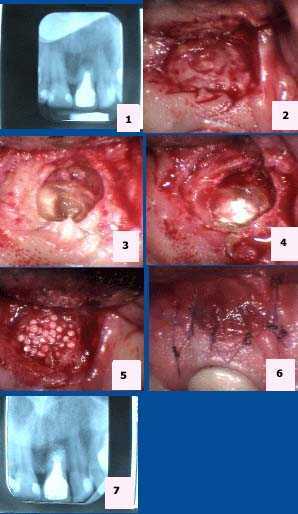
Pictures of Apicoectomy Surgery on tooth #9. 1) Pre-op x-ray of the periapical abscess. 2) Photo shows isolation of the apical area. 3) Exposure of the root apex. 4) Placement of MTA (mineral trioxide aggregate). 5) Placement of Bioplant HTR (hard tissue replacement). 6) 6-0 Vicryl sutures. 7) Post-op x-ray.

Endodontic – root canal – retreatment of tooth #29 and treatment of #28. The five-unit dental bridge had cement leakage and the teeth abutments decayed after only 1 and 1/2 years. The patient said that #29 was always sensitive after the original root canal was performed by her then general dentist. Retreatment of #29 by an endodontist – root canal specialist – revealed a second, previously undiagnosed and untreated second canal. A post space was created in this second canal after obturation.
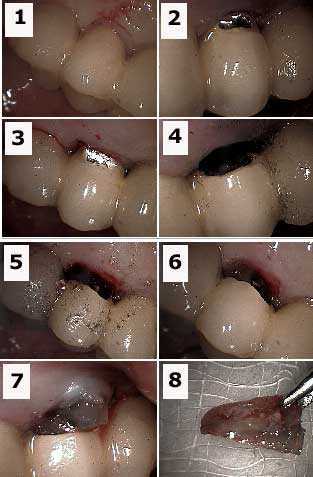
Technique for root resection from under a porcelain fused to metal bridge.
1) Labial view of an abutment with an endo-perio lesion. 2) & 3) Initial preparation into porcelain with a diamond bur. 4) Labial view showing preparation. The metal portion of the bridge is prepared with a steel bur. 5) Palatal view showing preparation. 6) Labial view showing the tooth root under the porcelain (gutta percha is visible in the tooth root). 7) Tooth root being extracted. The occlusal height of this root must first be reduced to allow it to exit. 8) The extracted tooth root.
1) Labial view of an abutment with an endo-perio lesion. 2) & 3) Initial preparation into porcelain with a diamond bur. 4) Labial view showing preparation. The metal portion of the bridge is prepared with a steel bur. 5) Palatal view showing preparation. 6) Labial view showing the tooth root under the porcelain (gutta percha is visible in the tooth root). 7) Tooth root being extracted. The occlusal height of this root must first be reduced to allow it to exit. 8) The extracted tooth root.

Tooth root resection from under a porcelain fused to metal dental bridge. 1) X-ray shows the distal abutment with an endo-perio lesion. 2) Labial photo of the same tooth. 3) Radiograph following resection (the metal chad in the area of the extracted abutment was later removed). 4) Labial view following extraction. This area could be filled in with bonding after healing. The occlusion on the distal cantilever was reduced. It opposed a lower full arch bridge so that supra-eruption was not a concern. Treatment options include: i) sectioning and removal of the distal cantilever, ii) implants, or iii) reevaluate over time with the patient informed to reduce function in this area.
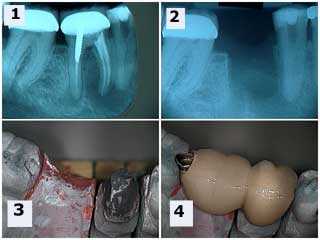
Two teeth dental bridge with an occlusal rest seat onto the rest preparation in the mesial of the second molar crown. This eliminates the need for removing the second molar dental crown. The premolar tooth did receive root canal therapy following healing of the extraction site after enucleation of the periapical abscess around the molar.
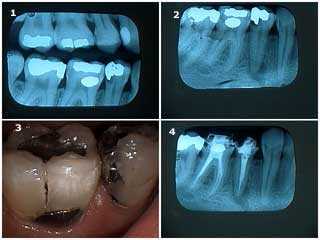
Emergency pain in the lower right quadrant teeth. 1) X-ray shows big cavities in the second premolar and first molar and smaller cavities in both the second and third molars. 2) There was also a large periapical radiolucency around the apex of the second premolar. 3) Photo of the second premolar and first molar. 4) Radiograph of the second premolar and first molar following root canal therapy. The patient felt better immediately following this. Note: these teeth were treated following a careful differential diagnosis. It would not be surprising, if in another patient, the pain came from a tooth with a less apparently severe problem.

Cervical decay and root canal infection around a lower right first premolar tooth. 1) A large radiolucency is seen in the x-ray. Note the distal abutment is the distal root of a first molar following hemisection. 2) Following root canal therapy. The cervical decay can now be seen more easily. 3) The working model in this picture shows the preparation of the mesial part of the distal two-unit bridge. This preparation will allow rigid connection to the new anterior bridge being made. 4) The new bridge section in place on the working model. 5) & 6) Two pictures of the new bridge showing the distal attachment. 7) An intraoral photo which mirrors the working model view seen in 3). 8) The final result. This patient was content to see the gold occlusal rest. Otherwise, it could have been hidden under porcelain.
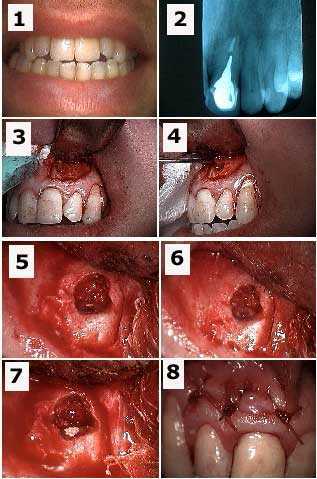
Locating the source of a draining fistula with the use of gutta percha and a post-op x-ray of the subsequent apicoectomy. Surgery pictures. Gutta percha can be gently placed into a draining fistula and identify the source of the periapical abscess without anesthesia.
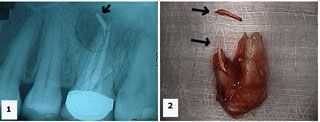
A hopeless tooth. 1) X-ray shows an upper first molar with gutta percha extruded into a large radiolucent area, the periapical abscess. 2) Palatal photo of the extracted tooth shows the extent of the gutta percha extrusion. The extra fragment shown is also gutta percha. [jm-o]